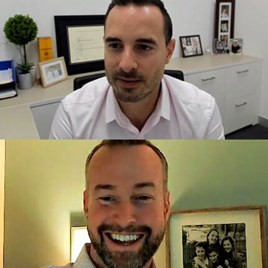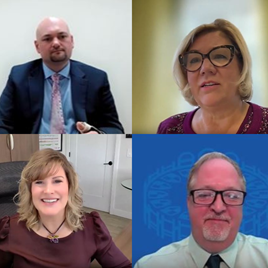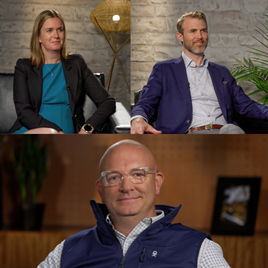Oct 26 2021 / Round the Table Magazine
READ 00:06:48
Lessons in Facebook branding
Topics Covered
Maybe clients aren’t sharing your social media posts as much as you’d like. Maybe you’re struggling to maintain digital traction with new potential clients. During a Zoom conversation in June 2021, two MDRT members shared how they have developed a strategy to generate more prospects through these posts.
Members participating:
- Carla Brown, FPFS, a 4-year MDRT member from Cuddington, England, UK
- Matthew Richard Duffy, FSS, LUTCF, a 7-year MDRT member from Murphysboro, Illinois, USA
Duffy: I’m not from this community. We’ve been here about 14 years, and when we got here, I didn’t know anybody. It’s taken time, but once you build those relationships in the community, the referrals come. But it’s never enough, so I’m very active on social media — more personally than professionally. About four years ago, we implemented this idea. When we had a new client, we would ask them if we could make a Facebook post welcoming them to our office as new clients. And they all said yes. We did that for about a year, and it got no action, no activity, no reach. It was a complete waste of time. No comments, no likes, no shares, no mentions. Nothing.
We had an office meeting to try and figure out what was going on. We realized that the only people who were seeing those posts were my current clients and friends. Those new clients’ friends weren’t seeing that because it was on my page. After we fixed that, it was a dramatic change for our business as far as marketing goes. We changed it to where we asked them to go to their social media and make a post about their experience coming to our office, and in return for that — we consider that a referral — we send them a Visa gift card.
It worked like a charm, and it still works like a charm. Now, all of their friends and also their friends’ connections are seeing that post. You have to believe that when they see that they are thinking, Wow, I’ve never felt that way when I’ve left an insurance or financial planning meeting. It’s usually a bad experience. I’ve certainly never left an insurance meeting and thought, I’ll go make a Facebook post and tell everybody how awesome this guy is.
The response has been dramatic. I’d get calls saying, “Hey, I know my buddy Joe had a good experience, and I need life insurance.” It’s been a huge factor for us, and it’s not me looking at the client face to face and saying, “Give me the name of three of your friends and family and phone numbers so I can call them.” I can’t do that; that’s not my personality. Random people in the community are walking up to me and asking me about insurance, and they’re people I don’t know. That never happened before, and that’s the only thing we’ve changed, so I know that’s where it’s coming from.
It’s a company-approved form that we use and a $25 Visa gift card that’s approved in the state of Illinois, so all that compliance is built in. It’s a professional piece that we give the client, and it looks good at work.
Brown: That’s a fantastic idea, Matt. Brilliant. We engage a lot more in social media now than we ever have before. We actually outsource our social media to an agency, so we’ve got regular posts going out, but we’ve consciously done the posts around brand-building rather than direct calls to action. We have learned that the posts that focus on the team, and also as individuals, get a lot more engagement than posts that are about products or investments or anything like that. People want to know about people, so we’ve just had a photo shoot done where we’re all wearing clothes that relate to our hobbies. We’re just trying to make the whole image a lot less corporate and more about us as individuals, and the engagement so far has been absolutely fantastic.
Duffy: I’m going to piggyback on what you said about the people. Very little of my social media engagement happens on my business page. On my personal page, almost all of my posts are my family, my hobbies and my pets. I’m probably overactive on social media, but I try. I want to get to know more people by sharing my hobbies with them. I want them to be able to relate. If I play golf, I’ll make a post about golf because I know there are people out there who play golf who I want to do business with. I’m a big hunter, so I post about hunting, but I keep it clean. If I want some hunters as my clients, I want them to be able to relate. I do that with my family and my children. My dog has his own Facebook page with 1,000 followers because I know so many people own pets. People come up to me in public and ask me “How’s Boots?” I don’t even know these people, but they are making a connection to me, and hopefully someday when they need our products or services, they’re not afraid to meet.
Brown: That’s a really good point. Last year, I took a negative and made it a positive. I had a post about how a client hadn’t turned up for a Zoom meeting. It was a beautiful day here — we do get them sometimes in England — so instead of being negative about the client not turning up, I grabbed the dog, put my trainers on and went for a run. I took a photograph of me and the dog out for a run and put it on LinkedIn. It got so much traction just showing that human side.
Do you have any processes to evaluate what is and isn’t working in this area?
Duffy: I have a nonscientific approach, but it works. I always go back and look through my previous posts on my memories on social media. And if I see a post that I made years ago that got giant traction, giant reach, I post it again. Because those posts were from five years ago, I might have 500 new friends or followers now who didn’t see them. Or because of algorithms, maybe nobody saw it. I do that all the time. And I don’t reshare it; I make it like it’s a brand-new post because those are the ones that get the most traction. Social media is really big for our business.
Brown: That’s a really good idea. Why reinvent the wheel if it worked the first time around? Love that. We haven’t been as active as Matt on social media or for as long. We have quarterly meetings with the agency we outsourced to so we can assess the reach, the engagement and the click-throughs to the website and other metrics, to figure out what’s worked and what hasn’t worked. We also have changed the strategy. They create for us a three-month social media plan, and we piggyback on certain days. We recently had Dementia Day, so it was Denim for Dementia. We all dressed up in denim in the office, and we put photographs of that on social media. It’s about looking back at the previous quarter and saying, “What has worked? What hasn’t worked? What should we do more of? What should we do less of? And what should we ignore completely?” I like Matt’s idea of going back and reusing posts. Once we’ve built up a big enough library, that’s a really good idea.
Duffy: Yeah, my library is pretty large. Ninety percent of my posts are personal, but I do throw probably one business-related post a week on my personal page because I want to make sure everybody knows I’m serious about what I do. And I want them to know what we do and that I want their business. I post just enough, I think, that people don’t block me because they get sick and tired of seeing my insurance posts.
Contact
Carla Brown carla.brown@sjpp.co.uk
Matthew Duffy matt.duffy@countryfinancial.com
Listen to this episode at mdrt.org/podcast.

![Beyond finance: Individuals outside the financial profession every financial advisor should learn from [Nirmal Debnath]](https://www.mdrt.org/globalassets/digizuite/32634-en-india_written-interview_nirmal-debnath-thumbnail.jpeg?height=268&crop=0,0,268,268)
![How to tailor financial advice to fit the unique needs and goals of your clients [Merryl Baptista]](https://www.mdrt.org/globalassets/digizuite/32635-en-india_written-interview_merryl-baptista-thumbnail.jpeg?height=268&crop=0,0,268,268)
![Anticipating the financial needs of Gen Z clients and advising prospects towards adequate insurance cover [Komal Atal]](https://www.mdrt.org/globalassets/digizuite/32632-en-india_written-interview_komal-attal-thumbnail.jpeg?height=268&crop=0,0,268,268)
![Enhancing your offline persona through cultivating an online presence: Tips and strategies [Khushboo Bajaja More]](https://www.mdrt.org/globalassets/digizuite/32630-en-india_written-interview_khushboo-bajaj-more-thumbnail.jpeg?height=268&crop=0,0,268,268)
![A former flight attendant's sky-high client servicing standards [Beth Daffodil Uy Tan]](https://www.mdrt.org/globalassets/digizuite/32577-en-ph-_video-interview_a-former-flight-attendant's-sky-high-client-servicing-standards_daffodil-tan-thumbnail.png?height=268&crop=0,0,268,268)



![Overcoming a financial advisor’s internal self-doubts [Cedrick Cruz]](https://www.mdrt.org/globalassets/digizuite/32509-en-ph_written-interview_-handling-a-financial-advisors-self-doubts-cedrick-cruz-thumbnail.jpg?height=268&crop=0,0,268,268)
![Why negative feedback is not a setback [Ella Grace Nuguid]](https://www.mdrt.org/globalassets/digizuite/32508-en-ph_written-interview_-turning-negative-feedback-into-opportunities-and-motivation_-ella-nuguid-thumbnail.jpg?height=268&crop=0,0,268,268)

![Financial advisor on-call: Strategies for engaging doctors [Mardeo Vellon]](https://www.mdrt.org/globalassets/digizuite/32490-en-ph_written-interview_-financial-advisor-on-call_strategies-for-engaging-doctors-_-mardeo-vellon-thumbnail.png?height=268&crop=0,0,268,268)